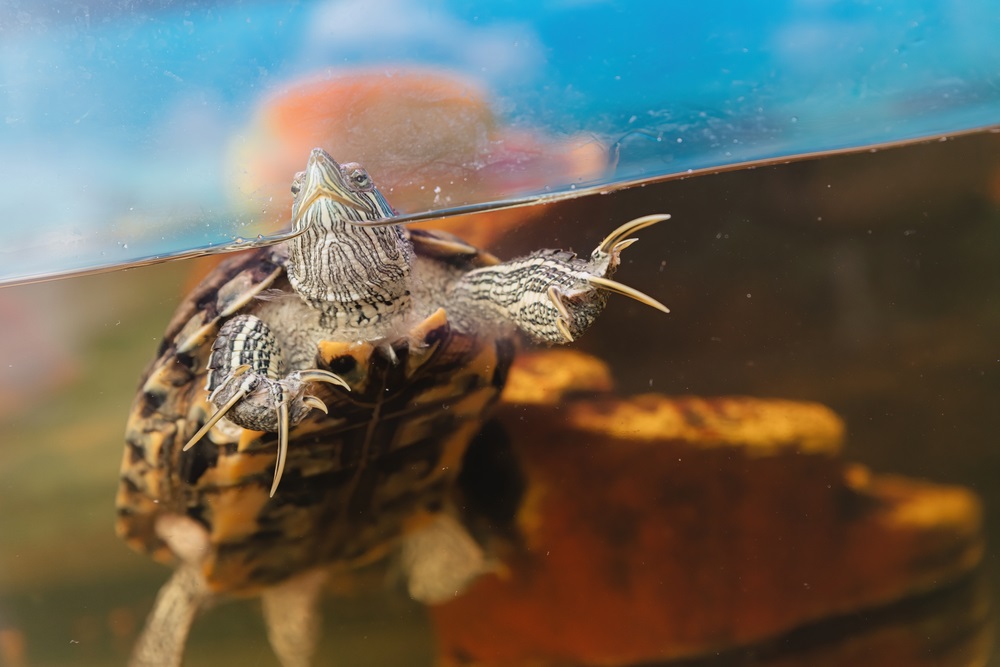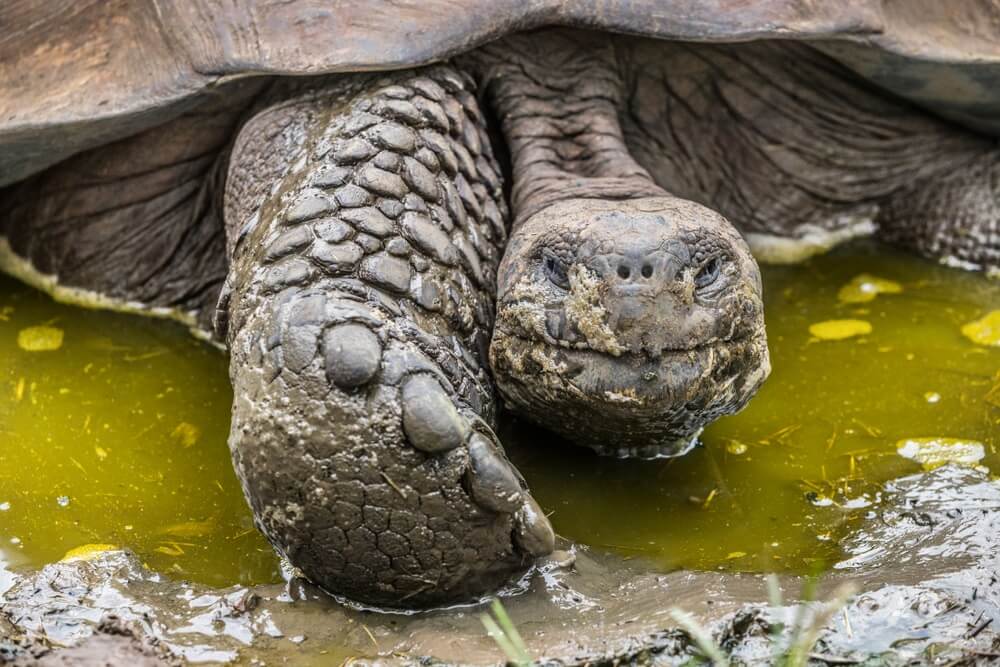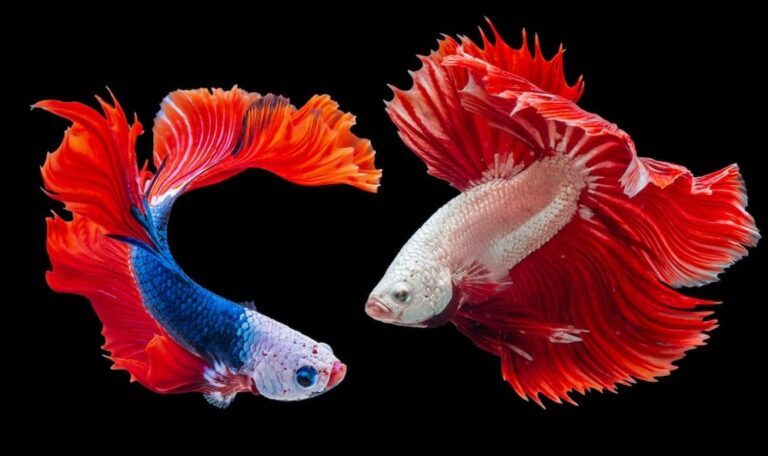Most turtle species are known to be wonderful swimmers. An aquatic turtle like the terrapin can live both in water and land. But what about tortoises? Tortoises and turtles are both reptiles. However, they differ regarding their liking of water, which makes us question, “Can tortoises swim?”
Tortoises cannot swim as much as most turtles do. That is why you should not leave them unattended near bodies of water. Living with a pet tortoise near the water raises the danger of drowning.
In this article, we will discuss how to keep tortoises safe, what kind of habitat they prefer, and how to let them enjoy the water safely.

Can Tortoises Swim?
Can tortoises swim? The direct answer is NO.
The main reason tortoises cannot swim is that they don’t have webbed feet. If you see a photo of a tortoise, it is easy to compare its feet to elephants. These feet have short toes and thick, short nails. The structure of a tortoise’s feet functions better on land than in water.
They also have a different leg shape, which isn’t ideal for swimming or paddling.
Another reason tortoises cannot swim as turtles do is because of their shell structure. A tortoise’s shell becomes heavy as they mature into old age. Most often, a tortoise scutes will weigh it down, making them sink deep into the water.
However, one kind of tortoise can swim, the leopard tortoise. Leopard tortoises can swim through rivers and lakes, albeit they do not make fine swimmers. Though they have thick legs, the front ones are shaped like a paddle. This shape allows them to swim slowly. Leopard tortoises also float with their heads above the water for hours. Hence, they don’t drown.
Differences Between Tortoises and Turtles

A freshwater turtle, a sea turtle and a tortoise may belong to the same order, but they certainly have different physiologies and habitats.
Habitat
An animal’s natural habitat plays a crucial role in its skills and ways of life. In the case of tortoises, they evolved over the millennia to adapt to land living. Their shells and claws can fight off land predators better than in water.
On the other hand, most turtles have spent most of their lives close to water bodies. Baby turtles have spent their younger years in and out of the water. Thus, it is not surprising why they can swim. However, some turtle species, such as box turtles, are not great at swimming. Though box turtles can swim, they cannot swim well in deep waters.
Flippers and Webbed Feet
As said earlier, the shape of the feet and legs of tortoises do not allow them to become amazing swimmers as opposed to turtles with flippers or webbed feet.
Like the green sea turtle, sea turtles have flippers, while freshwater turtles take pride in their webbed feet. These limbs let the turtles enjoy time in the water and on land. Walking turtles are slow and clumsy, but they can definitely walk a long distance if they have to. Moreover, females who have to lay their eggs always go to the shore to dig their nests.
Because tortoises lack flippers or webbed feet, they cannot enjoy the water as much as most turtle species do. However, their elephant-like feet and clawed toes are better suited for land life. The claws assist tortoises in digging a burrow.
Shell
The shells serve as protection for turtles and tortoises against predators. The presence of this protection also affects their abilities to swim. Swimming turtles have shells that are light and flat. These shell characteristics allow them to traverse water bodies easily. The water glides through the top shell of a turtle’s body, referred to as the carapace.
On the contrary, the dome-shaped shell of tortoises is quite heavy. Their shells also grow scutes layer after layer as they mature, becoming weighty as time goes by. Tortoises shed their scutes at some point. But, they only do so in thin layers. Due to the heaviness of their shell, tortoises are slow-moving animals on land. The massive weight of the shell will drag them down in the water, leading to drowning.
Can Tortoises Float?

After knowing that tortoises cannot swim, you may wonder if they can still float.
There are varying accounts of tortoises’ ability to float. However, some tortoise species, such as the leopard tortoise and Galapagos giant tortoise, can float in water. Unfortunately, not all tortoise species can do this.
Factors such as the shell type, size, age and the tortoise species affect their ability to swim. The type of water body and its depth are also factors in whether the tortoise can float or not. For shallow water bodies or a garden pond, a tortoise may come closer to the water to help cool their bodies off and survive.
While testing the floating capacity of tortoises on the water can get exciting, do not do this to your pets without checking their ability to stay afloat. Undue stress will cause them harm, and it’s not worth the risk.
How to Safely Bathe a Tortoise
Can tortoises swim? No. But, can you still safely bathe them? Yes.
Since tortoises cannot swim, taking necessary precautions when bathing them is a must. You may still bathe these pets in a tub. Just keep these guidelines in mind.
- An inch of water is more than enough to bathe tortoises. But, of course, this also depends on the tortoise’s size. Just make sure that the water level isn’t too high to submerge the head of the tortoise when standing or when lying down
- Always use lukewarm water for comfort
- Keep the tortoise on constant watch. Accidents such as flipping upside down may happen
- To clean a tortoise’s shell and legs, use a soft brush
- Do not use soap when bathing a tortoise, as this can harm its skin
- Always dry the tortoise after bathing and securely put it back in its enclosure
An adult tortoise can have baths twice to three times a week. Meanwhile, hatchlings or dehydrated pets must be bathed daily to keep them cool and help with their water deficiency.
Letting Your Tortoise Drink Water
You can find tortoises, both adults and baby tortoises alike, close to water bodies. That is because they also need to cool and hydrate themselves. Compared to other animals, some tortoises living in harsh environments, such as deserts, consume less water. Instead, they get their hydration from the food they eat. Tortoises love to eat fruits or any edible plant to their liking.
If a tortoise needs to drink, you can find this animal around ponds, streams and creeks. Tortoises in captivity also require their source of hydration. Tortoise pets need to have a shallow water bowl to easily drink without submerging themselves. Change the water daily to ensure that they always drink fresh water.
If you notice that your tortoise doesn’t drink, fret not. Tortoises can go on with their lives without drinking for a few days. However, always check on them to ensure they are still healthy and hydrated. And don’t forget to change their water daily.
A dehydrated tortoise may suffer from health conditions such as gout or kidney disease.
How to Save a Drowning Tortoise

Mixing up other species of turtles with tortoises is a problem for the unversed. Some people play with tortoises in the water, thinking they can swim. Sometimes, a pet tortoise may also fall accidentally into the water.
When a tortoise drowns, will you be able to save it?
A tortoise may become unconscious and unresponsive when it stays underwater for too long. There is also flaccidity, coldness, a decrease in pulse rate and no respiration. Sometimes, the tortoise may become blue due to the lack of oxygen. Tortoises can survive for a limited time, even without oxygen. But, prompt treatment is still necessary.
Saving a tortoise from the brink of death caused by drowning is doable. All you need is the right skill and knowledge on how to perform a first aid treatment for this animal.
- Flip the tortoise upside down. Open its mouth and gently press onto its flank in an attempt to remove some water
- Close the mouth and start an artificial mouth-nose recirculation. While holding the mouth close, blow into the tortoise’s nostril as forcefully as you can to inflate the lungs. Blow 10 to 20 times in one minute
- Repeat Step 2 for 13 to 15 minute
- If the tortoise remains unresponsive, bring it to the nearest vet clinic. The vet may insert a tube to remove the water from the inside
- If and when the tortoise survives, it will be fragile and weak for at least a couple of weeks. It should remain under constant supervision and care. The vet may also prescribe antibiotics, steroids, and other medications as needed






